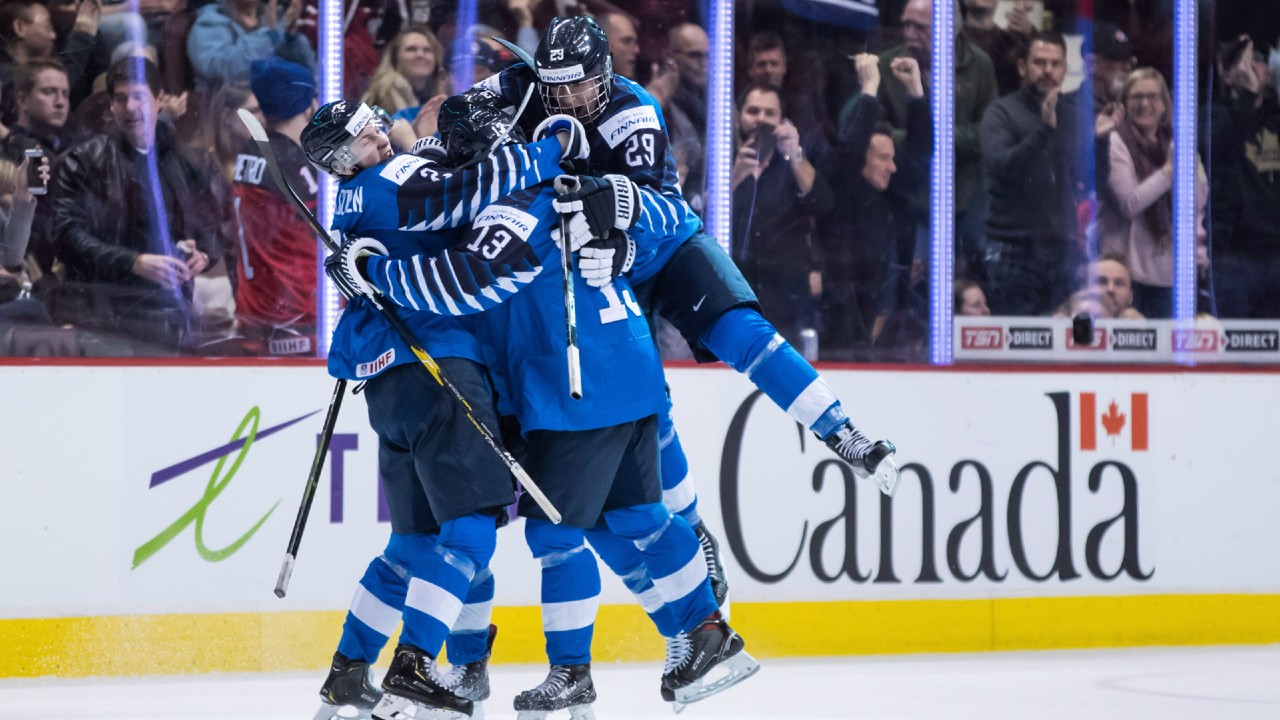No nation on hockey’s international stage has enjoyed a rise as steep and high-reaching over the past decade as Finland. Their run at the world juniors is evidence enough — after winning gold just twice in the first 36 years of the tournament, they’ve reeled off titles in three of the past seven tourneys.
Top prospect Anton Lundell was a key gear in the machine that was the nation’s most recent winning squad in 2019, centring highly touted wingers Kaapo Kakko and Eeli Tolvanen. The quietly reliable two-way centreman proved his worth during that gold-medal run, substituting flash for consistency and helping guide Finland to yet another top-spot finish.
[snippet id=4982512]
Here’s a look at all you need to know about Lundell, and why he could be one of the most under-appreciated centremen in this draft.
Team: HIFK Helsinki (Liiga)
Position: Centre
Shoots: Left
Hometown: Espoo, Finland
Age: 19 (October 3, 2001)
Height: 6-foot-1
Weight: 187 pounds
Golden Generation
A look at the top offensive talents in the game reveals the flourishing of Finland’s best at the NHL level. Aleksander Barkov, Sebastian Aho, Mikko Rantanen, Patrik Laine — the list isn’t short.
The next wave of talent joining that golden generation claimed world juniors gold in 2019. Jussi Ahokas was the head coach for that gold-medal run. And while his roster featured some names NHL fans might be more familiar with — New York’s Kakko, Nashville’s Tolvanen, Florida’s Aleksi Heponiemi, Chicago’s Henri Jokiharju — Lundell’s steady play was invaluable to their success, he says.
“For me, I knew we could trust him [to make] all the smart decisions,” Ahokas says. It was the reliability of that decision-making that raised Lundell’s stock in the eyes of the coaching staff.
“I would say his style is really high-end two-way centre. And that’s the thing — he doesn’t do flashy moves. He doesn’t catch your eye, but when you really look at him and how he plays, then you start seeing how good he actually is,” the coach continues. “His decisions that he makes, they affect positive things on the ice — it doesn’t have to be flashy.
“So, as a coach, you like him more than [if] you might have a really skilled guy who’s a flashy player, but doesn’t really give anything to the team. So that’s where I see why he’s so good.”
Though he’d gotten a glimpse of Lundell a few years earlier, and had a good sense of his game coming into the tournament, Ahokas says the teenager still exceeded expectations once the intensity of the title run ramped up.
“How well he played in that tournament, it still surprised me, of course. He played really well,” he says. “He started really well, but in the important games, he really stepped up his game. He competes really well — he plays better when the stakes are higher. That’s how I feel.”
It’s no surprise then, that the centreman — who’s a killer in the face-off circle — had a direct hand in Kakko’s goal with a minute and a half left in the gold-medal game, sealing the win over Team USA. While Kakko banged home the eventual winner, it was Lundell who won the draw that preceded the point-shot on the cage, Lundell who went to the net-front and got a few whacks at it before shuffling it over to Kakko to tuck home.
Quiet influence, resounding result.
Measuring Stick
There’s no question who the top dog of the 2020 NHL Draft is — Alexis Lafreniere has all but run away with that title. But that said, when Lundell went up against his draft class’s premier forward, his coach saw the young Finn’s potential emerge.
“For me, in the under-20 tournament, he played better than Lafreniere in that tournament,” Ahokas says of Lundell.
Neither prospect necessarily dominated on the scroresheet during the tourney, of course, Lafreniere finishing with just one point and Lundell finishing with four. But in terms of their overall game during that stretch, it was Lundell who was the better player, according to the coach who earned a gold medal in part because of it.
“Of course, Lafreniere is a great player. I haven’t seen him that much. But in that tournament — where we played against each other and I saw him play a little bit — in that tournament, in that point in time, [Lundell] was more of a player,” Ahokas says.
That’s not to say that Lundell might in fact be a better overall prospect than the Rimouski Oceanic standout, but rather, that the gap might not be as big as it seems.
It certainly wouldn’t be the first time that was the case, with Finland’s best often coming over as underrated hidden gems.
“Lafreniere, he’ll be a superstar. He’s a great player. But that tournament, when we were playing, [Lundell] played really well there — I would say people probably don’t know him that well,” Ahokas continues. “It goes with North America. Like Sebastian Aho, he was way underrated, he went second round. So, that can happen too.
“But whatever team drafts him will get a good player.”
Selke in Sight?
Like Ahokas says, the foundation of Lundell’s game his his two-way prowess — he’s a consistent, straightforward pivot who can win face-offs, drive possession, and play in every situation. But that responsible play causes some to overlook his offensive game, ignoring the fact that the two are inextricably linked.
“His hockey smarts or hockey intelligence — he reads the play really well,” Ahokas says of Lundell’s greatest strengths. “Really smart player. And he really positions himself really well on the ice. … Of course everybody says about his skating, is it good enough. But still, probably people don’t see how well he sees the ice, and how smart decisions he makes with the puck. And that’s a big thing.”
Nor should it be discounted, says Ahokas, how Lundell performed in the Finnish pro league against grown men over the past two seasons.
“He could play pro so well already this year — it’s totally different than playing junior league, playing pro hockey here in Europe,” says the coach, who now mans the bench for the Liiga team KooKoo, and thus saw Lundell do his thing among the pros as well.
“And at the under-20s he played really well also — two tournaments, under-18s he won and under-20s he won. So, there’s lots of good things. On the physical side he’s a late developer, so he’s been developing all the time, more and more.”
While there’s room for Lundell to progress physically, which will surely come with time, his greatest attribute is something far harder to gain down the line.
“The biggest thing for me is the hockey sense, and that’s [why] he can adapt well, [whatever] kind of situation it is,” Ahokas says. “That’s the hardest thing to coach, the hardest thing to get. You can always find skaters, but those who really understand the game, that’s the harder part.”
Which is why when Lundell does eventually get a shot to make that jump, he’s in line to join the growing list of Finnish phenoms to thrive in the North American game. Ahokas would know, having coached a fair few of them during this time with the national program.
“I’ve coached Kakko, I’ve seen Aho, Mikko Rantanen, all the top guys who are developing right now. And I think he’s out there with the top, top guys,” says the veteran coach.
And in fact, given Lundell’s performance for HIFK this season and last, he might even have a leg up over those predecessors, and should be set up to eventually follow their footsteps to the NHL.
“The thing is, actually, how he played so young, but how he played in the pro league already in his draft year, not many of those guys played so well, while he did. … Going to the NHL speed, it’ll take a little bit of time. But I don’t see why he wouldn’t be able to take that step.”
[relatedlinks]









